What are the different types of reflection?

Reflectance is measured by shining light on a sample and measuring the light reflected from the sample. Reflected light consists of specular reflected light and diffuse reflected light, which when combined is referred to as total reflected light (specular reflected light plus diffuse reflected light). The figure here shows a diagram of these types of reflected light. The light shone onto the sample is called the incident light and the angle formed between the incident light and sample is called the angle of incidence. The incident angle is represented with the symbol θ.
Specular reflected light is the light reflected from shiny mirror-like surfaces at the same angle as the incident angle. Diffuse reflected light is the diffuse light reflected in all directions from rough surfaces, such as paper and powder surfaces. Total reflected light is the total combination of specular and diffuse reflected light. Total reflected light is often measured when measuring samples that have both rough and shiny characteristics, such as plastic and painted samples. The methods used to measure specular, diffuse, and total reflected light are referred to as specular, diffuse, and total reflected light measurement methods, respectively.


